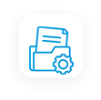Port automation is the application of Artificial Intelligence (AI) or automated machinery to improve the efficiency of logistics operations. A typical port automation process refers to automated logistics operations within a distribution center or warehouse aided by supply chain engineering systems and Enterprise Resource Planning (ERP) systems.
A little hindsight can reveal the fact that from the steam engine, to the forklift, to present-day’s robotic pickers and packers, the history of logistics also speaks a history of automation.
There are many economic and technological trends that shape the transformation of port automation. Along with the advancement in automation technologies, the two major trends driving port automation are an escalating shortage of labor, and an ever-increasing demand from online retailers. According to an estimate by McKinsey Global Institute, the logistics and warehousing industry, among various sectors, has the third-highest potential for automation.
The Key Areas of Port Automation
The key areas of port automation or logistics automation are comprised of both the hardware and software sides.
The Software
Area Port automation or logistics automation uses automation software or cloud-based software as a service (SaaS) solutions to automate the workflow and management of supply chain systems. Though there is no rule to generalize the system and workflow, most commercial logistics companies use one or more custom automation solutions.
The arsenal of automation software is classified into three categories: integration software, operational control software, and business control software.
- The Integration Software: It allows overall control of the automation machinery. For instance, the connection of cranes to conveyors for smoother stock movements.
- Operational Control Software: This software helps the logistics system make common decisions such as where to keep the incoming containers or where to get them when requested.
- Business Control Software: This software system aids higher-level functionalities such as identifying incoming stock deliveries, scheduling the fulfillment of orders, and assigning goods to outgoing trailers.
Some of the major automation software used in the conventional department of a logistics company include Consignment Transport Management Solution (CTMS) software. CTMS software is also used in the container trucking department. The warehouse department is handled by Warehouse Management Software (WMS) and Warehouse Control System (WCS) automation software.
The Hardware Area
The software component is the brain of the logistics automation systems and the hardware components are its limbs.
- Fixed Machinery: This hardware area has automated storage and retrieval systems (ASRS or AS/RS), including cranes, conveyors, and vertical carousels. It also includes sortation systems that can divert goods more quickly and distribute high volumes of small containers to a large set of locations.
- Movable Machinery: This department has mobile machinery such as industrial robots, motion check weighers, and Automatic Guided Vehicles (AGVs) that utilize LiDAR sensors to capture accurate position data on people, objects, and port infrastructure. These sensors are also increasingly becoming valuable for port equipment and vehicles to implement automation at port terminals.
- Radio Technology: The logistics automation software connected to radio communication terminals can provide instructions to warehouse operators on the move. Barcode scanners attached to these terminals allow quick and accurate identification of containers.
Benefits of Port Automation
Port automation comes with a good number of benefits, and some of the major ones are mentioned below.
- Real-time access to complete data analysis: The real-time access to a complete data analysis of the logistics process helps the management make better business decisions.
- Brings down costly mistakes: Making mistakes in the logistics business is an expensive affair. A great number of mistakes can happen in the manual operation and data entry process of the logistics business. The automation process helps to bring it down and saves costs for the company.
- An efficient organizational structure and control: The logistics automation systems are usually flexible enough to adapt to the company’s business objectives and rules. At the same time, they are powerful enough to compel all workers, both internal and external, to follow the policies that ensure efficient and profitable logistics businesses.
- Improved customer service: Improved customer service is the result of the automated real-time tracking of cargo, auto pick-up, and delivery, keeping adequate cargo insurance and accounting along with incorporating it into the order specifications.
- Swiftness and scalability: The logistics automation systems provide ease of order entry into the system -- for instance, a warehouse -- and manage them with greater agility. In addition, no matter how many shipments you dispatch and receive in each location, all transit invoices can be consolidated into a single, easily comprehensible invoice.

 Factory Automation
Factory Automation Logistics Automation
Logistics Automation Process Automation
Process Automation Crane Collision Avoidance
Crane Collision Avoidance LiDAR/Obstacle Detection
LiDAR/Obstacle Detection Safety Laser Scanners
Safety Laser Scanners Optical Data Transmission
Optical Data Transmission Hot Metal Detectors
Hot Metal Detectors Laser Distance Sensor
Laser Distance Sensor Blog
Blog Whitepapers
Whitepapers Case Studies
Case Studies Infographics
Infographics